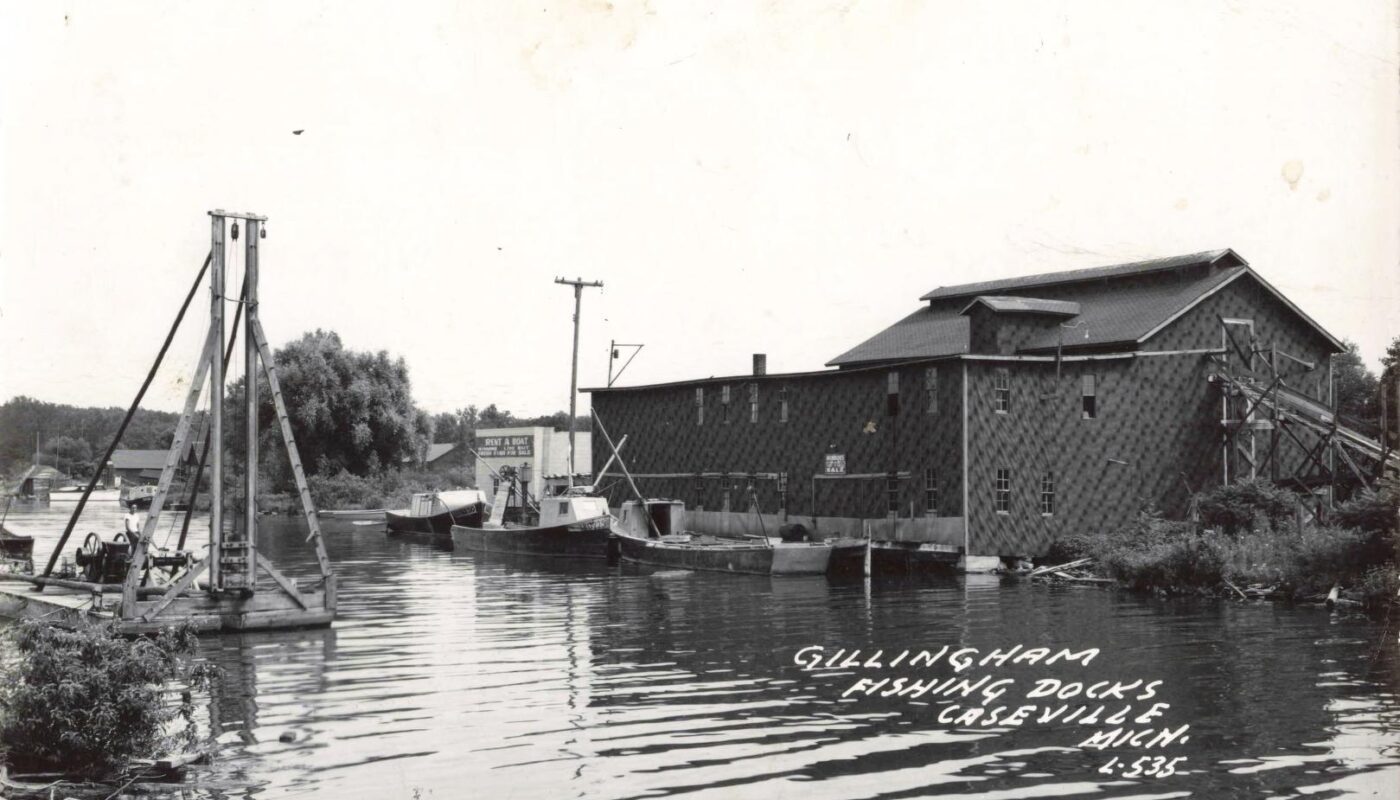On the quiet waters of the Pigeon River in Caseville, Michigan, a black-and-white postcard captures a time when the fishing industry shaped the economy and identity of Michigan’s Thumb region. The image, marked “Gillingham Fishing Docks – Caseville, Mich.,” likely dates back to the 1930s or early 1940s. It stands as a visual record of the once-thriving commercial fishing operations that served communities up and down the Lake Huron coast.
The Gillingham Fish Company’s Role
The R.L. Gillingham Fish Company is at the center of this scene, a name well-known in Michigan’s maritime history. The Gillingham operation was one of the cornerstones of Caseville’s fishing trade, catching and shipping thousands of pounds of whitefish, perch, and herring to Detroit, Chicago, and other regional markets.
The postcard shows several fishing tugs in front of a large wooden processing house. With a patterned exterior and visible conveyor system, the building was built for efficiency, designed to move fresh catch from boats to processing lines quickly.
Early Signs of Tourism and Industry Mix
To the left of the image, a wooden derrick or crane system hints at the equipment used to unload nets or lift small craft. Nearby, a painted sign reads “Rent A Boat,” suggesting that Gillingham’s business extended beyond wholesale fish. This crossover into tourism reflects a period when the Great Lakes served industry and recreation. Caseville’s waters became a draw for vacationers, anglers, and tourists long before it was known for cheeseburgers and summer festivals.
Michigan’s Fishing Boom and Decline
At its height, Michigan’s commercial fishing industry was a powerhouse. In the early 1900s, the Great Lakes yielded millions of pounds of fish each year. Family-run businesses like Gillingham’s played a vital role in supplying the Midwest’s growing urban centers. The cold waters of Saginaw Bay were ideal for commercial operations, and Caseville, with its natural harbor and access to key shipping routes, was well-positioned for success.
But the industry began to change by the mid-20th century. Invasive species like the sea lamprey devastated native fish stocks. Pollution from agriculture and industry affected water quality. New state and federal regulations added costs and limited catch sizes. The once-booming operations in Caseville, Bay Port, and Port Austin began to dwindle. Many fishing companies closed or were consolidated. The Gillingham Docks eventually ceased operations, marking the end of an era for Caseville.
The Line to the Present: Bay Port Fish Company
Still, a link to the past remains. Today, Bay Port Fish Company continues the legacy of commercial fishing on Saginaw Bay. Run by descendants of the area’s original fishing families, the company operates under strict sustainability practices. Their catch is still processed by hand, much like in Gillingham’s day.
But even this modern operation faces new threats. Warming lake temperatures, algal blooms, and proposed environmental legislation could make commercial fishing in Lake Huron unworkable within a generation.
Preserving a Working Waterfront’s Memory
With its one-cent postage and classic riverfront view, this postcard preserves a moment in time that feels both distant and familiar. It’s a reminder that Caseville’s history wasn’t built only on summer cottages and beachfront parties but also on the backs of working boats and the men who hauled in the catch, season after season.




